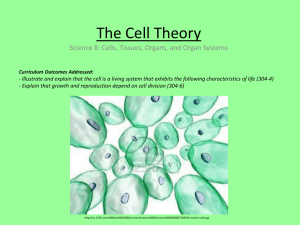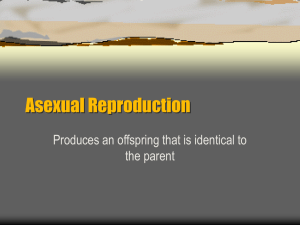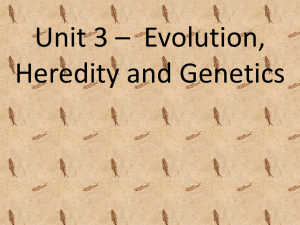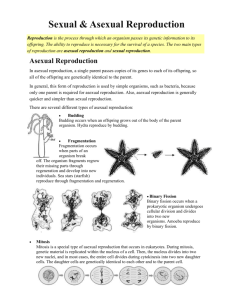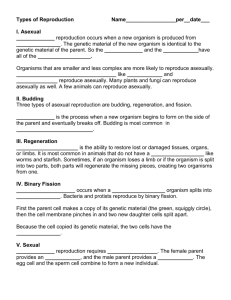Mitosis webquest-roes - mr-roes
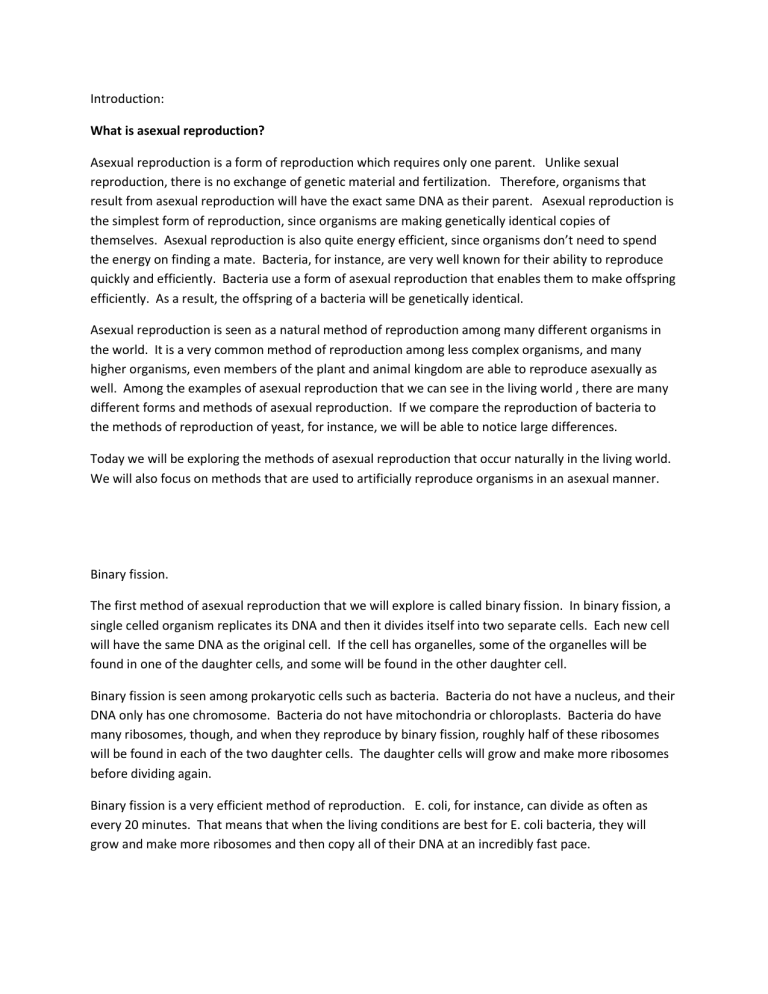
Introduction:
What is asexual reproduction?
Asexual reproduction is a form of reproduction which requires only one parent. Unlike sexual reproduction, there is no exchange of genetic material and fertilization. Therefore, organisms that result from asexual reproduction will have the exact same DNA as their parent. Asexual reproduction is the simplest form of reproduction, since organisms are making genetically identical copies of themselves. Asexual reproduction is also quite energy efficient, since organisms don’t need to spend the energy on finding a mate. Bacteria, for instance, are very well known for their ability to reproduce quickly and efficiently. Bacteria use a form of asexual reproduction that enables them to make offspring efficiently. As a result, the offspring of a bacteria will be genetically identical.
Asexual reproduction is seen as a natural method of reproduction among many different organisms in the world. It is a very common method of reproduction among less complex organisms, and many higher organisms, even members of the plant and animal kingdom are able to reproduce asexually as well. Among the examples of asexual reproduction that we can see in the living world , there are many different forms and methods of asexual reproduction. If we compare the reproduction of bacteria to the methods of reproduction of yeast, for instance, we will be able to notice large differences.
Today we will be exploring the methods of asexual reproduction that occur naturally in the living world.
We will also focus on methods that are used to artificially reproduce organisms in an asexual manner.
Binary fission.
The first method of asexual reproduction that we will explore is called binary fission. In binary fission, a single celled organism replicates its DNA and then it divides itself into two separate cells. Each new cell will have the same DNA as the original cell. If the cell has organelles, some of the organelles will be found in one of the daughter cells, and some will be found in the other daughter cell.
Binary fission is seen among prokaryotic cells such as bacteria. Bacteria do not have a nucleus, and their
DNA only has one chromosome. Bacteria do not have mitochondria or chloroplasts. Bacteria do have many ribosomes, though, and when they reproduce by binary fission, roughly half of these ribosomes will be found in each of the two daughter cells. The daughter cells will grow and make more ribosomes before dividing again.
Binary fission is a very efficient method of reproduction. E. coli, for instance, can divide as often as every 20 minutes. That means that when the living conditions are best for E. coli bacteria, they will grow and make more ribosomes and then copy all of their DNA at an incredibly fast pace.
Why is binary fission important?
Since binary fission is an efficient method of asexual reproduction, the genetic information of one bacteria can quickly be multiplied. That means that if one bacteria has a genetic mutation that gives it an advantage in an environment, it will flourish and reproduce. Those two cells have this same genetic mutation, and the will both grow and reproduce as well. The four cells that result from these two cells splitting will then grow and reproduce as well. In a short period of time, there will be a large number of offspring bacteria which have this novel mutation.
In short, binary fission allows for the rapid production of genetically identical bacteria, since it is an energy efficient method of reproduction.
Budding
Yeast
Most yeast cells and hydras reproduce by a process called budding. This process is not to be confused with plant growth or germination—this natural method of reproduction is seen in a different kingdom altogether!
Budding in yeast cells is similar to the binary fission seen in bacteria, but there is an important difference. In budding, the daughter organism begins its life much smaller than the mother organism.
Just like how binary fission starts, budding begins with a replication of the DNA. However, unlike how bacteria split into two equal portions, yeast cells begin to reproduce by producing pushing their DNA outward to into a small region to its side. This region becomes a distinct ‘bud’ off of the mother cell.
The bud will grow and develop as it receives nourishment from the mother cell. Eventually, the daughter cell will be big enough to break off and survive on its own. The final result will be two cells that are genetically identical, but the daughter cell will be a bit smaller than the mother cell when it first breaks off.
Hydras:
Hydras are simple, hollow organisms which live in fresh water systems such as lakes, streams, and ponds or rivers. They are usually only a few millimeters long and are able to be easily seen with a microscope.
Hydras have a tubular body that is topped with tentacles. They have a primitive nervous system, and move in a tumbling or cartwheel motion by continually bending their body over and gripping the surface that they are living on. They have a mouth area in the center of their tentacles, and a digestive region in the center of their tubular body. Hydras eat small aquatic insects by catching them with their tentacles and bringing them into their mouth.
Hydras can reproduce both sexually and asexually. Their method of asexual reproduction is the same method that yeast cells use to reproduce: budding. An adult hydra will begin the process of budding by producing a bulging region along their tubular body. This bulging region will grow and develop and form small tentacles at its tip. The small region will continue to grow and develop until it is large enough to support itself. Eventually the daughter hydra will break off from the mother hydra and will be freeliving. The daughter hydra, being produced asexually, will be genetically identical to the mother hydra, but will begin its independent life smaller than its mother.
Sporulation:
You’ve likely seen a piece of bread, cheese, or even fruit with white-ish green mold on it. What you probably didn’t know is that the mold that you see is actually an entire colony of tiny fungus organisms growing on closely together. In reality, the moldy bread likely has fungus growing all over it by the time you see an entire colony.
Bread mold spreads by air-born spores. These spores are extremely tiny and can travel long distances by being blown through the air. These fungus spores will germinate when they land on a suitable food source and will grow tiny hyphae into their food to gather nutrients. As the fungus grows and develops, it will grow what are called sporangia which are tall, skinny, spore-bearing structures. As these sporangia develop, they will release spores, which are genetically identical to the mother plant.
Sporulation is an efficient method of asexual reproduction since it produces thousands of tiny spores— each of which can spread and develop into a genetically identical adult. Sporulation is important because it allows sessile organisms the ability to disperse offspring in a manner that is typically seen only in plant seeds.
Bread molds can also undergo sexual reproduction. The details of the process can be found here: http://bcs.whfreeman.com/thelifewire/content/chp31/31020.html
(this webquest does not require that you learn about them, but it is interesting.)
Vegetative Reproduction.
Many plants reproduce asexually by various methods. It is important to remember before we begin to discuss methods of asexual reproduction in plants that plants are an entire kingdom, and a very large one at that. Just like in the animal kingdom, there are simple plants that are capable of doing things that higher plants cannot, and there are more complex plants that can do things that simple plants are incapable of.
Most asexual reproduction seen among plants is through the use of specialized modified stems.
Strawberry plants and spider plants, for instance, reproduce by growing a plantlet at the end of a runner. A runner is a specialized horizontally growing, above ground stem that produces a plantlet at its end or at its nodes. Runners are fast growing and some plants have runners that can scale up buildings or across landscapes.
Another method that plants use to reproduce asexually is bulbs. Bulbs are thick, fleshy leaves that are wrapped around each other to create a round mass under the surface of the soil. These thick leaves grow on a modified short stem that lies beneath the leaves. The roots of the plants grow out of this stem region. Onions and tulips are examples of plants that grow a bulb. Bulbs act as an asexual reproductive structure by allowing the plant to die back nearly entirely during the winter and then grow back in the spring.
Rhizome
Rhizomes are stems that grow underground like a root. Rhizomes travel underground away from a mother plant to produce daughter plants nearby. Various plants, from bamboo to water lilies reproduce asexually through the use of rhizomes. Most types of grasses produce rhizomes as a method of asexual reproduction. Rhizomes produce genetically identical plants in an area surrounding the mother plant.
Artificial methods of vegetative reproduction.
Many times throughout the course of human history we have discovered plants that have beneficial aspects. When we find a plant that we want more of, we have often have gathered seeds from it, and planted these seeds elsewhere. However, seeds are the product of a plant’s sexual reproduction, and many times these seeds don’t have the exact same qualities that the mother plant did.
In these times, we have tried to find ways to make plants reproduce asexually. In our interactions with plants throughout the course of history, we have arrived with various methods of reproducing plants in a way that gives us genetically identical plants.
The first of these methods is taking cuttings. When we take a cutting of plant, we remove a portion of the mother plant that can be safely lost without damaging its health. This portion may be a root, stem, or leaf portion. In order to make the removed portion of the plant become a new plant, gardeners will put the plant in damp soil or water for a period. Since most plants have undifferentiated cells at key locations throughout the plant, the cut plant can use its stored sugars and starches to produce the necessary organs that it needs. Once established, the gardener can plant the newly grown plant, and it will grow into a healthy, mature plant.
Another method that is often used by gardeners is called grafting. In grafting, a healthy stem of desirable plant is creatively attached to the stem of a less desired plant. In time, the region between these two similar plants grows and the vascular system mends together to create a continuous system of xylem and phloem. Once this has occurred, the foreign stem will receive nourishment and grow as if it was still growing on its own mother plant.
Grafting is used very commonly for fruiting trees. Sometimes, a fruit tree may have desirable fruit, but its root system will be poor. To resolve this issue, gardeners will choose a similar tree species that has a strong root system. They will remove most of the stems of the plant with the strong root system, and will graft on healthy stems from the fruit tree with desirable fruit.
Plants that are grafted together will not modify their own genetic information in any way, and they also won’t exchange their DNA with each other. Instead, the original portions of the plant will continue to grow and develop as their DNA instructs, and the portions of the plant that have been grafted on will grow and develop as their own DNA instructs.


